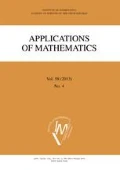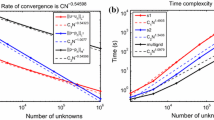Abstract
In this paper, a new mixed finite element method is used to approximate the solution as well as the flux of the 2D Burgers’ equation. Based on this new formulation, we give the corresponding stable conforming finite element approximation for the P 20 − P 1 pair by using the Crank-Nicolson time-discretization scheme. Optimal error estimates are obtained. Finally, numerical experiments show the efficiency of the new mixed method and justify the theoretical results.
Similar content being viewed by others
References
R. A. Adams: Sobolev Spaces. Pure and Applied Mathematics 65, Academic Press, New York, 1975.
H. Bateman: Some recent researches on motion of fluids. Mon. Weather Rev. 43 (1915), 163–170.
N. Bressan, A. Quarteroni: An implicit/explicit spectral method for Burgers’ equation. Calcolo 23 (1986), 265–284.
J. Cadwell, P. Wanless, A. E. Cook: A finite element approach to Burgers’ equation. Appl. Math. Modelling 5 (1981), 189–193.
H. Chen, Z. Jiang: A characteristics-mixed finite element method for Burgers’ equation. J. Appl. Math. Comput. 15 (2004), 29–51.
P. G. Ciarlet: The Finite Element Method for Elliptic Problems. Studies in Mathematics and Its Applications. Vol. 4, North-Holland Publishing Company, Amsterdam, 1978.
J. Crank, P. Nicolson: A practical method for numerical evaluation of solutions of partial differential equations of the heat-conduction type. Proc. Camb. Philos. Soc. 43 (1947), 50–67; Reprint in Adv. Comput. Math. 6 (1996), 207–226.
Y. Duan, R. Liu: Lattice Boltzmann model for two-dimensional unsteady Burgers’ equa- tion. J. Comput. Appl. Math. 206 (2007), 432–439.
C. A. J. Fletcher: A comparison of finite element and finite difference solutions of the one- and two-dimensional Burgers’ equations. J. Comput. Phys. 51 (1983), 159–188.
Y. He: Two-level method based on finite element and Crank-Nicolson extrapolation for the time-dependent Navier-Stokes equations. SIAM J. Numer. Anal. 41 (2003), 1263–1285.
Y. He, J. Li: Convergence of three iterative methods based on the finite element dis- cretization for the stationary Navier-Stokes equations. Comput. Methods Appl. Mech. Eng. 198 (2009), 1351–1359.
Y. He, W. Sun: Stability and convergence of the Crank-Nicolson/Adams-Bashforth scheme for the time-dependent Navier-Stokes equations. SIAM J. Numer. Anal. 45 (2007), 837–869.
Y. He, W. Sun: Stabilized finite element method based on the Crank-Nicolson extra- polation scheme for the time-dependent Navier-Stokes equations. Math. Comput. 76 (2007), 115–136.
F. Hecht, O. Pironneau, A. Le Hyaric, K. Ohtsuka: FREEFEM++, version 2. 3–3, 2008. Software available at http://www.freefem.org.
J. G. Heywood, R. Rannacher: Finite-element approximation of the nonstationary Navier-Stokes problem. IV. Error analysis for second-order time discretization. SIAM J. Numer. Anal. 27 (1990), 353–384.
P. Huang, A. Abduwali: The modified local Crank-Nicolson method for one- and two- dimensional Burgers’ equations. Comput. Math. Appl. 59 (2010), 2452–2463.
H. Johnston, J. G. Liu: Accurate, stable and efficient Navier-Stokes solvers based on explicit treatment of the pressure term. J. Comput. Phys. 199 (2004), 221–259.
Z. Luo, R. Liu: Mixed finite element analysis and numerical simulation for Burgers equa- tion. Math. Numer. Sin. 21 (1999), 257–268. (In Chinese. )
A. K. Pany, N. Nataraj, S. Singh: A new mixed finite element method for Burgers’ equa- tion. J. Appl. Math. Comput. 23 (2007), 43–55.
Y. Shang: Initial-boundary value problems for a class of generalized KdV-Burgers equa- tions. Math. Appl. 9 (1996), 166–171. (In Chinese. )
L. Shao, X. Feng, Y. He: The local discontinuous Galerkin finite element method for Burger’s equation. Math. Comput. Modelling 54 (2011), 2943–2954.
F. Shi, J. Yu, K. Li: A new stabilized mixed finite-element method for Poisson equation based on two local Gauss integrations for linear element pair. Int. J. Comput. Math. 88 (2011), 2293–2305.
Z. Weng, X. Feng, P. Huang: A new mixed finite element method based on the Crank-Nicolson scheme for the parabolic problems. Appl. Math. Modelling 36 (2012), 5068–5079.
Author information
Authors and Affiliations
Corresponding author
Additional information
The research has been supported by the NSF of China (Grant No. 11401511 and 11271313) and the Scientific Research Program of the Higher Education Institution of Xinjiang (Grant No. XJEDU2014S002).
Rights and permissions
About this article
Cite this article
Hu, X., Huang, P. & Feng, X. A new mixed finite element method based on the Crank-Nicolson scheme for Burgers’ equation. Appl Math 61, 27–45 (2016). https://doi.org/10.1007/s10492-016-0120-3
Received:
Published:
Issue Date:
DOI: https://doi.org/10.1007/s10492-016-0120-3
Keywords
- Burgers’ equation
- mixed finite element method
- stable conforming finite element
- Crank-Nicolson scheme
- inf-sup condition




